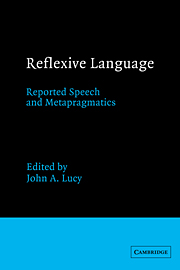Book contents
- Frontmatter
- Contents
- Acknowledgments
- General introduction
- Part I Theoretical foundations
- Part II The relation of form and function in reflexive language
- Introduction to Part II
- 3 The boundaries of reported speech in narrative discourse: some developmental aspects
- 4 Metapragmatic presentationals: reporting speech with quotatives in Yucatec Maya
- 5 Metalanguage and pragmatics of deixis
- 6 Learning what to ask: metapragmatic factors and methodological reification
- Part III Text, context, and the cultural functions of reflexive language
- Part IV Interpretation, reported speech, and metapragmatics in the Western tradition
- Name index
- Subject index
Introduction to Part II
from Part II - The relation of form and function in reflexive language
Published online by Cambridge University Press: 22 January 2010
- Frontmatter
- Contents
- Acknowledgments
- General introduction
- Part I Theoretical foundations
- Part II The relation of form and function in reflexive language
- Introduction to Part II
- 3 The boundaries of reported speech in narrative discourse: some developmental aspects
- 4 Metapragmatic presentationals: reporting speech with quotatives in Yucatec Maya
- 5 Metalanguage and pragmatics of deixis
- 6 Learning what to ask: metapragmatic factors and methodological reification
- Part III Text, context, and the cultural functions of reflexive language
- Part IV Interpretation, reported speech, and metapragmatics in the Western tradition
- Name index
- Subject index
Summary
Part II, “The relation of form and function in reflexive language,” explores how the two levels of functioning in a reflexive utterance are formally related. Usually, a given language provides a variety of formal techniques for reporting and describing speech which native speakers learn. One important dimension of contrast, at issue in these chapters, is the degree of formal explicitness with which a portion of the utterance is marked and then characterized as object language. The ease, range, or subtlety of metalinguistic activity will depend not only on the availability of formal devices of certain sorts but also on the metalinguistic norms current in the culture. In particular, language researchers bring to their encounters with informants highly developed and explicit reflexive concerns and understandings which interact with, and perhaps conflict with, native concerns and understandings (both tacit and ideological). Effective research requires that investigators understand native forms and their uses and that they be sensitive to the theoretical and practical significance of less formally regimented descriptive practices (e.g., use of narrative scenarios).
The first two chapters deal with naturally occurring techniques for reporting speech and separating metalinguistic usage from ordinary usage. In Chapter 3, Hickmann traces the emergence in English-speaking children of the capacity to separate reported speech from reporting speech in recounting a staged verbal interaction between puppets.
Information
- Type
- Chapter
- Information
- Reflexive LanguageReported Speech and Metapragmatics, pp. 61 - 62Publisher: Cambridge University PressPrint publication year: 1993
